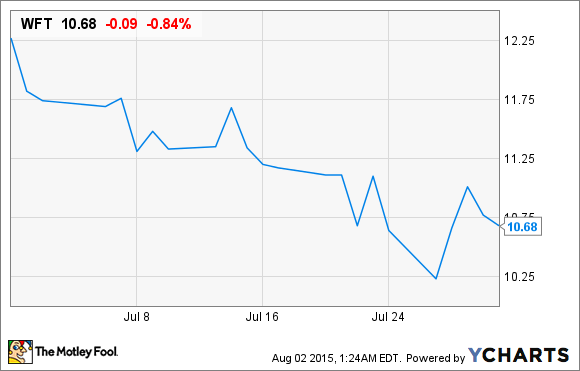Shares of Weatherford International (NYSE: WFT), an equipment and services provider to the oil and gas industry, sank 13% in July based on data from S&P Capital IQ, after the company reported disappointing second-quarter earnings results.
For the quarter, Weatherford reported total revenue of $2.39 billion, a year-over-year decline of 36% and a sequential quarterly decline of 14%. Operating income fell an even steeper 77% year-over-year. The culprit, as you probably have surmised, is weak global prices for crude, which has reduced the demand for drillers to produce. On an adjusted basis Weatherford lost $0.10 per share after generating a profit of $0.24 per share in Q2 2014. Although its loss was $0.02 narrower than expected, Weatherford's outlook didn't exactly give investors much to cheer about.
Looking ahead Weatherford foresees no quick rebound in the oil market, and as such plans to cut even more jobs in order to reduce its expenses. As of the end of the second-quarter Weatherford had jettisoned 97% of its planned 10,000 jobs, and it announced plans to cut an additional 1,000 jobs going forward (principally within the United States). Weatherford notes that it's also closed more than 60 operating facilities through the first-half of 2015 and has plans to close roughly 30 more before the end of the year.
Although Weatherford should remain free cash flow positive in the second-half of 2015, its forecasted improvement in net income in the second-half is directly tied to another $100 million reduction in projected capital expenditures.
Long story short, Weatherford is pulling every lever it can to reduce its expenses as its revenue tumbles, and investors are clearly concerned.
Source: Weatherford International.
The question that should be asked here is whether Weatherford is merely a temporarily broken stock or a broken business model.
Personally, my inclination is to lean toward Weatherford merely being temporarily broken. The primary factor standing in the way of proclaiming Weatherford as an outright "buy" candidate is its substantial debt. As the company noted in its latest quarter, it did manage to reduce its net debt by $107 million, but it still has more than $7 billion in short- and long-term debt. If the downturn in oil prices drags out for many years Weatherford could find itself in a bind.
But, aside from its high debt levels Weatherford appears conservatively positioned to take advantage of an eventual rebound in drilling demand – a rebound that doesn't seem too far-fetched considering the growing oil demands of emerging markets. Weatherford's cost-saving actions should help it generate positive free cash flow as long as crude oil prices don't fall much further.
However, the true buy signal for Weatherford remains U.S. rig counts. Though falling rig counts are potentially bad news for Weatherford, a reduction in supply is almost certainly needed to stem the freefall in crude prices. I'd suggest keeping a close eye on weekly rig count data and using this as your signal of when to begin edging into oil equipment stocks like Weatherford.







